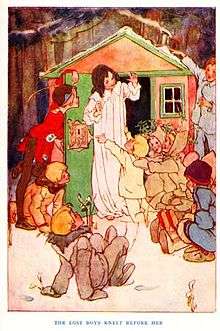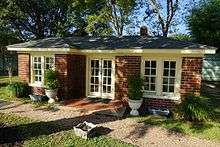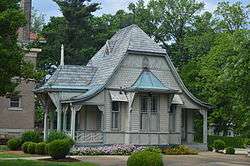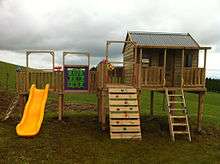Wendy house

A Wendy house or playhouse is a small house for children, large enough for one or more children to enter. Size and solidity can vary from a plastic kit to something resembling a real house in a child's size. Usually there is one room, a doorway with a window on either side, and little or no furniture other than that which the children improvise.
The original was built for Wendy Darling in J. M. Barrie's play, Peter Pan, or The Boy Who Wouldn't Grow Up. Wendy was shot by the Lost Boy Tootles after arriving in Neverland, so Peter Pan and the Lost Boys built a small house around her where she had fallen. It was inspired by the wash-house behind Barrie's childhood home in Kirriemuir[1] and first appeared in story form in The Little White Bird in which fairies build a house around Mamie Mannering—the prototype for Wendy—so protecting her from the cold.[2]
A prop house was created by Barrie for the first stage production of the play in 1904. It was constructed like a tent so that it could be erected quickly during a song which Wendy starts with:
I wish I had a darling house
The littlest ever seen,
With funny little red walls
And roof of mossy green.[2]
John's hat was used as a chimney and a slipper was used as a door knocker. Toy manufacturers soon created replicas of the stage Wendy house, which have become a standard toy found in British gardens ever since.[1]
South African usage
In South Africa, Wendy houses are a form of accommodation for low-income people. The structure is usually erected in someone's backyard. Although many people may view this as temporary accommodation, many families have lived in such a structure for years. It is very common among the black population in South Africa; among the larger black population it is often constructed from corrugated iron instead of wood.
The term "wendy house" usually refers to the wooden temporary accommodation, although there are various other types. Corrugated iron structures are called "shacks", while cement board structures are called "nutecs".
Among the more affluent population, wendy houses are used as entertainment huts, children's playhouses, or for storage.
Playhouses for children around the world


Globally, the term playhouse is more generic and more common than the term Wendy house. A few online companies offer rustic, inflatable, or corrugated iron varieties: these are usually set up by the individuals directly to avoid the price increase that comes with external suppliers. Most of the online established companies set up only wooden or nutec structures. The quality of these companies varies greatly. A playhouse may become a hide-away, fort, club house in a child's imagination or simply a place to "play house" in imitation of adult behavior. Treehouses or tents sometimes serve as a playhouse or secret vantage point for children.

A Cubby House is another name for playhouses. There are both indoor and outdoor children's playhouses and manufactured kits for assembly by adults or children. A playhouse may become a hide-away or club house in a child's imagination. Treehouses built by or for adults are often appropriated by children as a secret vantage point and may become a safety concern.
See also
| Wikimedia Commons has media related to Playhouses. |
Notes
- 1 2 Philippa Lewis, Everything You Can Do in the Garden Without Actually Gardening
- 1 2 Michael Cordner, Peter Pan and other plays, Oxford University Press